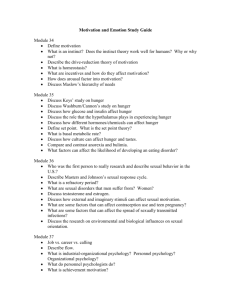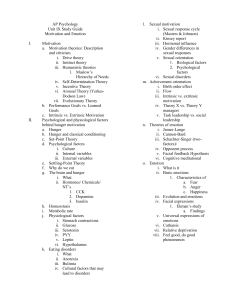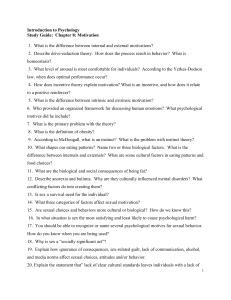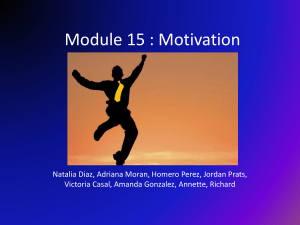Reading Guide – MOTIVATION & EMOTION
advertisement
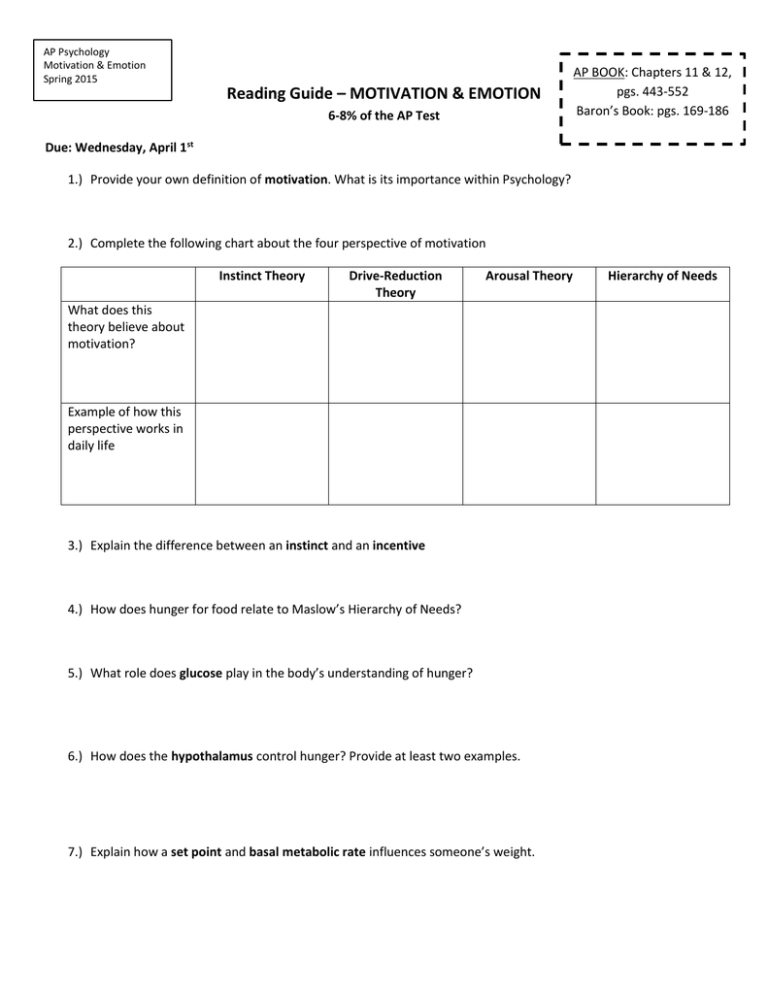
AP Psychology Motivation & Emotion Spring 2015 Reading Guide – MOTIVATION & EMOTION 6-8% of the AP Test AP BOOK: Chapters 11 & 12, pgs. 443-552 Baron’s Book: pgs. 169-186 Due: Wednesday, April 1st 1.) Provide your own definition of motivation. What is its importance within Psychology? 2.) Complete the following chart about the four perspective of motivation Instinct Theory Drive-Reduction Theory Arousal Theory What does this theory believe about motivation? Example of how this perspective works in daily life 3.) Explain the difference between an instinct and an incentive 4.) How does hunger for food relate to Maslow’s Hierarchy of Needs? 5.) What role does glucose play in the body’s understanding of hunger? 6.) How does the hypothalamus control hunger? Provide at least two examples. 7.) Explain how a set point and basal metabolic rate influences someone’s weight. Hierarchy of Needs 8.) Fill in the following chart for the psychological and cultural factors that influence hunger Taste Preferences Eating Environment Eating Disorders More influenced by genetics or culture? Or both? Description of this influence on hunger 9.) What body types are at the highest risk for being obese? What are some other obesity risk factors? 10.) List some social stereotypes of being obese. How do these influence obese people throughout their lives? 11.) Fill in the chart below to explain the factors that influence obesity. Fat Cells Set Point & Metabolic Rate (pg. 451) How do they influence obesity? Example(s) 12.) How was the sexual response cycle originally created? 13.) Describe each of the stages below (Just need to know the basics) a. Excitement phase: b. Plateau phase: c. Orgasm phase: d. Resolution phase: 14.) How do estrogen and testosterone influence sexual motivation? Genetic Factor Food & Activity Factors 15.) Explain the difference between external and imagined stimuli in reference to sexual motivation. 16.) Is the adolescent sex rate more influenced by genetic or cultural factors? 17.) List some of the cultural influences that lead to teen pregnancy and/or sexually transmitted infections. 18.) How do psychologists define sexual orientation? 19.) What are some of the populations and people groups that homosexuals tend to be more prevalent in? 20.) Complete the following table to describe influences on sexual orientation Brain & Biology Genetics Prenatal Hormones What is their influence on sexual orientation? Example(s) 21.) What do survival rates and the need to continue living have to do with motivation? 22.) Define ubuntu. How does this influence the need to belong? 23.) Why do some people continue to sustain relationships that do not actually benefit them? 24.) What is the difference between job, career, and calling? How do they influence motivation at work? 25.) How did Csikszentmihalyi discover the concept of flow? 26.) Fill in the chart below to describe the subfields of Industrial-organization psychology (Prologue) What does this subfield do? What type of work place might these psychologists be in? Specific examples of the work they complete Personnel Psychology Organization Psychology Chapter 12 – Emotions, Stress, & Health 27.) What three components create an emotion? 28.) Fill in the chart below to explain each theory of where emotions come from James-Lange Theory Cannon-Bard Theory Two-factor Theory What does this theory argue? Using the example and images (pg. 499) of a car accident, explain how this theory explains the order of emotions 29.) How do the sympathetic nervous system and parasympathetic nervous system differ? 30.) Provide some examples of physiological differences between emotions. 31.) What is the spillover effect? Use the hormone-injected males as an example. 32.) How does the “low road” influence our emotions? 33.) What did Dr. Richard Lazarus argue about our ability to feel emotions? Do you agree with his findings? 34.) Describe the importance of nonverbal cues in understanding emotions. Provide an example. 35.) Are women better at detecting emotion and attitude than men? Why or why not? 36.) Take the facial emotion “test” on page 512. What does this tell us about universal facial expressions? 37.) Explain James Laird’s experiment with facial expressions. What does this do to emotions? 38.) Fill in the chart below to explain three of the ten basic emotions Fear Anger Happiness What role does this emotion play? How is it learned? How is it genetic? How can it be calmed? 39.) What is subjective well-being? 40.) Using the graph on page 523, explain the correlation between money and overall happiness. 41.) Do you agree with the following quote: “Gross national happiness is more important than gross national product.” Why or why not? 42.) Fill in the chart below to explain understanding of emotions Adaptation-Level Phenomenon Relative Depravation What is it? Example(s) 43.) List at least three factors that, in general, do NOT influence overall happiness 44.) Why was the field of behavioral medicine created? 45.) Provide a definition of stress. 46.) Explain the role that Walter Cannon played in explaining human’s response to stress. 47.) What is the opposite response to “flight or fight?” 48.) Complete the following chart to describe the General Adaptation Syndrome (GAS) Phase #1 Phase #2 Name of phase What happens during phase 49.) Explain why our body “stresses out” in each of the following situations a. Catastrophes b. Significant Life Changes Phase #3 c. Daily Hassles 50.) Describe how Friedman and Rosenman measured the correlation between coronary heart disease and stress 51.) What emotions lay at the core of Type A individuals? 52.) Complete the following chart to explain the body’s susceptibility to disease when stressed Psychoneuroimmunology AIDS Cancer How is it influenced by stress? How does it affect the body? 53.) What role do each of the following behaviors play in controlling and coping with stress? a. Perceived control: b. Optimism: c. Social Support Systems: d. Aerobic Exercise: e. Biofeedback: f. Spirituality:





